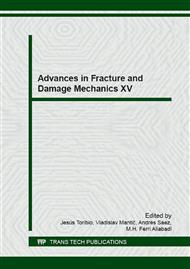p.212
p.216
p.220
p.224
p.228
p.232
p.236
p.240
p.244
Helium Effects on 316L Austenitic Stainless Steel Fracture Mechanism
Abstract:
The most common fracture mechanism of nuclear reactor internals is irradiation-assisted stress corrosion cracking (IASCC). Its susceptibility at relatively low dose is dominated by conventional mechanisms such as radiation-induced segregation and radiation hardening. However, the aging of the nuclear fleet combined with the increase of their life-span reveals other mechanisms that could play an important role on IASCC susceptibility. A large amount of helium (He) can be accumulated in reactor internal components of pressurized water reactors (PWR) after long term operation. This occurrence could significantly increase (or even dominate) the IASCC susceptibility at high doses. He has been homogeneously implanted in an especially designed miniaturized specimen at 300°C up to 1000 appm. Slow strain rate tests (SSRT) results in high temperature air and in simulated PWR conditions indicate that homogenized, as-implanted He does not have a significant effect on IASCC up to 1000 appm under these test conditions.
Info:
Periodical:
Pages:
228-231
Citation:
Online since:
September 2016
Authors:
Price:
Сopyright:
© 2016 Trans Tech Publications Ltd. All Rights Reserved
Share:
Citation:


